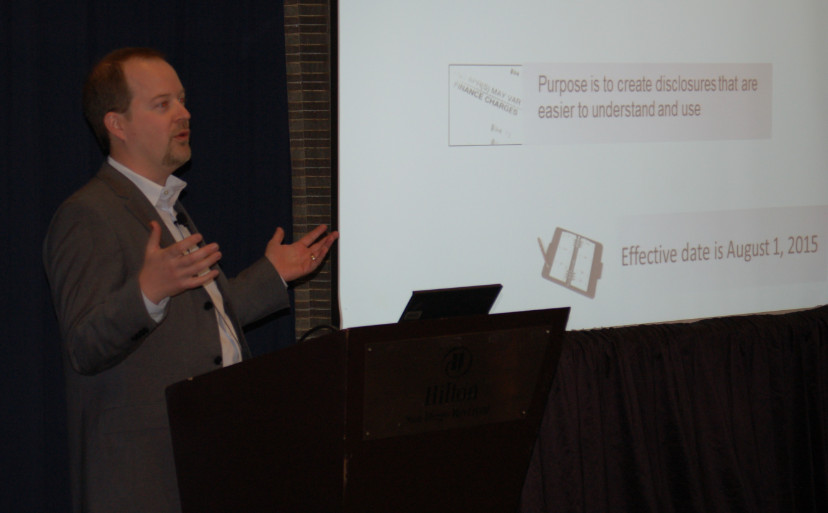Press

TILA/RESPA changes looming: credit unions prepare today
CUNA Mutual Group Speaker Guides CUNA Lending Council Conference Attendees; How to Prepare System, Document, and Service Providers
SAN DIEGO, CA (November 4, 2014) — Credit unions must act now to prepare for the Consumer Financial Protection Bureau (CFPB)’s combined disclosure rule stemming from the Dodd-Frank Act’s changes to the Truth in Lending Act (TILA) and Real Estate Settlement Procedures Act (RESPA). The integrated disclosure rule directly affects the people, processes and technology credit unions use to support their lending operations, CUNA Mutual Group’s Regulatory Compliance Manager Jon Bundy told a CUNA Lending Council Conference breakout session audience today.
“The CFPB’s TILA/RESPA Integrated Disclosure Rule is the largest mortgage lending regulatory compliance change seen by credit unions in recent times,” said Bundy. “Specifically, the rule will impact credit unions’ relationships with their system, document, and service providers, and, most importantly, their members and credit union staff.”
The rule was issued in November 2013 to simplify and improve disclosures consumers receive when applying for and closing on mortgage loans. Bundy reminded audience members that the new disclosures are not merely replacing or combining the existing disclosures. “The regulations require loan disclosures to change dynamically to reflect each borrower’s unique loan features, which means the new documents will have new data elements, calculations, and restrictions, and incorporate dynamic elements based on loan type, loan feature, and loan purpose,” said Bundy.
Taking everything into consideration Bundy told attendees there could be thousands of permutations of the new disclosures because of the dynamic nature of the documents. To be fully prepared, credit unions must start making and documenting business decisions regarding the type of lending programs offered, and fees and services charged.
“Systems will need to be updated with new data fields and calculations, so it is critical that credit unions work with their system and document providers now to make sure they are on track,” Bundy said. “Procedures should be established to guarantee service providers and settlement agents are walking in step with the credit union to address restrictions and timing limitations.”
Bundy continued his Lending Council Conference session with a detailed examination of the new disclosure documents, and the associated implications and impacts. The new Loan Estimate replaces the Initial TILA Disclosure and the RESPA Good Faith Estimate, which is provided three business days after the lender receives an application. Then, the Closing Disclosure replaces the Final TILA Disclosure and HUD-1 Settlement Statement, which is provided three business days before closing.
“Verify with your document providers that they have you covered with the disclosures for your specific loan types, and make sure you get them in time to test and train,” said Bundy.
Lenders will need to work more closely with their service providers, too, to know what fees will be charged for their services and to provide accurate contact information for service providers in the members’ areas. “Start by examining how accurate your Good Faith Estimates are compared to your HUD-1 and HUD-1A,” said Bundy. “Then, determine which services are appropriate to shop for and which are not. If the member cannot shop, make sure you know how much they will be charged because of the zero tolerance,” Bundy added.
Credit unions will also need to develop a number of new processes with their settlement agents, including one to guarantee timely delivery of the Closing Disclosure and who needs to provide a corrected Closing Disclosure when something changes.
“Now is the time to determine who is in charge, what the credit union’s compliance resources are, how the credit union’s departments are impacted, and how your third-party partners can help,” said Bundy. “The compliance deadline is looming. It’s just around the corner. Don’t get caught unprepared, start having these discussions today.”
The TILA/RESPA rule becomes effective and must be complied with on Aug. 1, 2015.
Bundy concluded his session by reminding attendees of the resources available to them at www.consumerfinance.gov/regulations, and for CUNA Mutual Group LOANLINER customers at www.cunamutual.com/tilarespa.
CUNA Mutual Group was founded in 1935 by credit union pioneers, and our commitment to their vision continues today. We offer insurance and protection for credit unions, employees and members; lending solutions and marketing programs; TruStage™ – branded consumer insurance products; and investment and retirement services to help our customers succeed. More information is available on the company’s website at www.cunamutual.com.
CUNA Mutual Group is the marketing name for CUNA Mutual Holding Company, a mutual insurance holding company, its subsidiaries and affiliates. Life, accident, health and annuity insurance products are issued by CMFG Life Insurance Company. Property and casualty insurance products are issued by CUMIS Insurance Society, Inc. Each insurer is solely responsible for the financial obligations under the policies and contracts it issues. Corporate headquarters are located in Madison, Wis.
